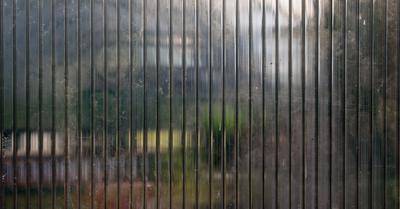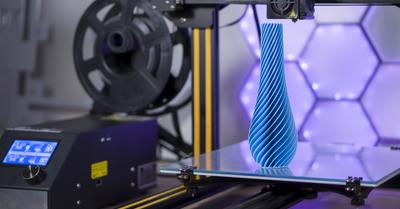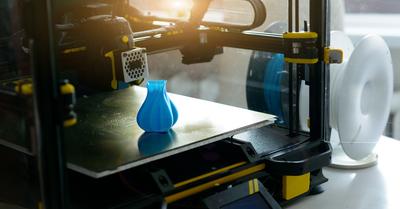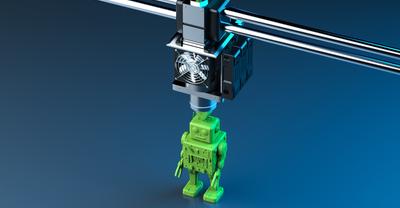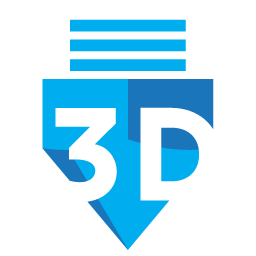PolyJet Vs FDM
Before we get into the meat of the differences between the two processes, it’s important to understand the way each one works. Knowing how each operates can make it easier to see the exact differences between them and how that could affect your project.
We won’t give a deep explanation of all their mechanics, just a brief overview.
An Overview of PolyJet
PolyJet is the newer of the two systems and is mostly used for:
- Model prototyping
- Artwork
- Any application where various materials are needed in a single print
It works, in essence, by laying down a thin bit of a liquid photopolymer, then curing it with a UV light. A photopolymer is just a type of polymer that will harden and cure when exposed to a high amount of UV light. They form the whole basis for the PolyJet system.
In that sense, PolyJet works the most like a traditional printer, if it helps to think of it that way. Much like a normal printer has multiple nozzles for each color, a PolyJet printer can print with several nozzles that each lay a different photopolymer. Being able to print a project made from multiple types of materials in a single print cycle is a huge benefit of the PolyJet system.
An Overview of FDM
FDM (Fused Deposition Modeling) is what most people think of when they think 3D printing. It prints using a thermoplastic that has been extruded into a filament (a strand, like a string). The FDM machine feeds the filament through a head which melts it, then deposits the melted plastic as it prints. The melted thermoplastic actually fuses together as it touches (hence the name).
This leads to two main advantages:
- Stronger finished product
- Lower operating costs
However, this leads FDM to underperform in some other categories, which we’ll cover below.
How Large of a Part Can They Print?
The maximum size of the parts you can print has a large bearing on how you can approach a project. Luckily, both FDM and PolyJet are roughly equally matched in this regard.
Stratasys, a company which produces both FMD and PolyJet machines, says that:
- PolyJet parts can be: 39.3 x 31.4 x 19.6 in
- FDM parts can be: 36 x 24 x 36 in
PolyJet can only print a maximum depth of 19.6 in, but that isn’t a major concern for most projects.
FDM does have an advantage in this category, though not necessarily in the way you would think. FDM can print much larger pieces with the caveat that they be broken down into manageable segments first. This means that a huge piece can be printed and them bonded together after the fact, essentially allowing you to print a much larger piece than the printer would technically allow.
Fusing materials after the fact is easier with FDM than with PolyJet, though it does depend on the type of filament you used to print. Still, most experts consider FDM a better choice for building a single large piece from many smaller bonded pieces.
Printer Footprint and Workspace Requirements
While the maximum printing size may be similar, that isn’t the only size variable that you should be thinking about. When shopping for a new 3D printer you also need to keep in mind what kind of space you can dedicate to it.
Because of their simplified nature, FDM printers tend to be more compact than their PolyJet counterparts. This allows even a large printer to still fit on a desk or workbench. Granted, it would take up a large fraction of the workspace, but it can still fit there.
PolyJet printers take more space due to several factors:
- The holding tanks for all the multiple printing materials
- Having multiple printing nozzles for each material, along with their feed hoses and other miscellaneous supporting gear
- Needing a UV light mounted to the printing head
All the tech needed to make their amazing capabilities feasible has to go somewhere, and that means that a PolyJet printer is going to be larger than its FDM counterpart. This is most apparent at the largest sizes, where a PolyJet printer with the largest maximum printing size is going to need a space set aside specifically for it.
Their Level of Detail and Precision
Perhaps one of the areas where the most progress has been made in 3D printing in recent years is the level of detail which can be printed to. Early 3D printers could only make rudimentary shapes, while modern ones can create pieces of detailed artwork all by themselves. How does FDM and PolyJet stack up to each other when it comes to the level of detail they can achieve?
PolyJet Prints Very Fine Details
PolyJet is the clear “winner” in this category. It has the capability of producing very fine detail on objects and can even leave a smooth finish.
It can accomplish this mainly because of its use of liquid polymers. Using a liquid base instead of a filament base like FDM means that the PolyJet printer can lay down very thin layers of material at a time. The practical upshot of this is that they can almost totally get rid of “layer lines” when using the proper materials. Layer lines are just the visible and tactile lines left behind by other 3D printing methods as they print layers on top of each other.
This leaves you with several advantages:
- Designs require very little polish afterwards
- Pieces can be used directly as showpieces
- Sculptures or other art pieces are easier to produce
FDM Prints Detail, but Not with Extreme Precision
While FDM may not be able to achieve the same level of detail that PolyJet can, that doesn’t mean it’s a slouch when it comes to fine detail. FDM printers can still produce complex pieces with a certain amount of fine detail, and a lot of it has to do with the type and thickness of filament you’ll be printing with.
FDM printers were the big kid on the block for a long time, and they are certainly capable of printing in detail. Just don’t expect the same level of fine precision detail that a PolyJet can achieve.
AMFG has this to say about FDM precision:
“When designing small features for FDM, the recommended feature size for engraved details is 1mm thickness and 0.3mm depth to ensure legibility. The minimum size for columns and pins also needs to be considered during the design stage: these features should be no less than 2mm in diameter to be printable.”
So, while it may not be PolyJet levels of detail, you still have a good amount of precision to work with.
The Materials Each Can Use
The amount, type, and flexibility of the materials you can use plays a large role in the design process. Having access to a larger material selection can increase the flexibility you have in your 3D designs, but it can also bring unexpected costs along with it. We’ll explore more below.
PolyJet Is Flexible
One of PolyJet’s main advantages over FDM is its ability to print with multiple materials simultaneously. It’s able to do this because it uses liquid polymers which only need a UV light in order to cure and harden. There are many different types of these compounds, which means there are many different types of material you could print with.
This puts PolyJet in a unique and exciting place in the 3D printing world. Printing with multiple materials simultaneously opens the door to a plethora of options, especially when you consider the types of materials a PolyJet system can print with. These include:
- Materials with different levels of tensile strength
- Rubbery materials
- Materials with different amounts of flex
- Transparent materials
- Materials that contain all sorts of dyes and patterns
- Biodegradable materials
The list truly goes on and on. Just make sure to use a material that your machine’s manufacturer has approved.
FDM Focuses on Practicality
Again, while FDM may be behind the curve compared to the PolyJet’s flexibility of material, that doesn’t mean it’s not flexible at all. In fact, an FDM system can print with a large amount of materials as well—just a different subset of materials.
FDM systems are focused around fast, cheap, strong parts. This influences the types of materials which are available to print with. While they may not be able to print much in the way of flexible material, they excel at printing low cost, high performance materials—something which the PolyJet lacks.
Overall, an FDM machine excels at printing materials which are strong, durable, and chemical or heat resistant. This makes it a great option if you expect your printed parts to go straight into service themselves.
Stratasys lists FDM machines as being:
- Better at printing durable materials
- Better at printing with high performance materials
- Just as good as PolyJet at printing rigid and bio-compatible materials.
How Much Does Each Cost to Run?
The cost of maintaining and stocking a 3D printer is a valid concern for businesses and hobbyists alike. Luckily, the overall cost of 3D printing has become much less of a hurdle as technology develops, but there are still cost differences between PolyJet and FDM printing.
PolyJet: Expensive Complexity
Out of the two methods, PolyJet is the more expensive for several reasons which we’ll cover below. However, the cost difference isn’t massive—just big enough that potential buyers should know beforehand.
PolyJet is the most complex of the two systems, and the unfortunate reality is that with complexity comes cost. For starters, the liquid polymer materials can be more expensive than filament (although that obviously depends on what type you are purchasing and in what quantity).
The nozzles are also a concern, as not only does it have several instead of one, but they also wear out faster just due to the printing process. Much like traditional printer heads, they go through a lot of wear and tear during the course of printing.
Additionally, the method PolyJet uses means that the piece will require more support structures (scaffolding) compared to the same FDM print. In practical terms, this means you’ll be using more feed liquid than an FDM would use filament to print the same item. You use more, therefore, you buy more.
To round up, expect to spend more maintaining a PolyJet system because:
- The liquid polymers cost slightly more (typically)
- You use more polymer to print the same item
- The nozzles cost more to replace
- The nozzles are replaced more often
FDM is Cheap and Effective
FDM is a proven technology in the field and is known for being cost effective and sturdy. Especially when printing with high-efficiency materials, the cost of printing with an FDM can be a decent bit below its PolyJet counterpart.
The filament used in FDM printers can vary in cost, but at a basic level it’s very cheap and cost effective to print with. Additionally, the structural strength of the filament and the way an FDM machine prints means that you’ll need fewer support structures along the way, which translates to reduced material usage (and therefore reduced operating cost).
FDM printers, having been around the longest of the two, also have a wider range of nozzles available—both in terms of cost and quality. Buying a cheap nozzle will just result in low quality prints. However, generally speaking, the cost of an FDM nozzle is going to be a decent bit cheaper than a PolyJet nozzle due to its increased lifespan and (relatively) low complexity.
FDM printers:
- Cost less to stock with filament (typically)
- Require fewer support structures, and therefore less filament per item
- Have lower prices for replacement nozzles
- Need nozzle replacements less frequently
How Fast Can Each Print?
The speed at which a 3D printer can produce items depends on multiple complicated factors, including:
- The complexity of the design
- The materials being used
- The printer being used
- The levels of detail and precision needed
- The support density needed
As you can see, there are a lot of factors that go into how fast the printer can spit out your object. Additionally, the equation of printing speed doesn’t capture the full picture—if you print an item in 4 hours that takes 8 hours to finish outside the machine, you aren’t better off than printing for 6 hours and only needing 2 hours to finish it.
In order to tackle this question correctly, we’ll need to consider all the factors involved.
PolyJet Can Be Fast
Most sources claim that PolyJet has a faster build speed than FDM. In general, this seems to be true. PolyJet can print at speeds which an FDM machine can’t keep up with.
However, this gets complicated because of the flexible nature of the PolyJet machine. Like we stated above, there are a lot of factors that go into the printing speed. PolyJet can print faster, but there are also factors which can slow down the process, like:
- Intricate detailing
- Using a high density filling for interior chambers
- Overall height of the design
Apples to apples, a PolyJet Machine will almost always print the same object at a faster speed than an FDM machine. However, in practical use, the objects you’ll be printing will likely be more complex which adds to print time—so in this sense, it can turn out to be a wash.
FDM: How Low Resolution Can Beat High Speed
In cases where you just need something quick, an FDM printer could actually be the best choice. If the item you need is simple, robust, and doesn’t require much detail, then an FDM printer can spit it out relatively quickly.
Now, as we said, a PolyJet will almost always be faster in a straight up contest of the same printed piece. However, because the FDM machine prints at a much lower resolution, simple pieces can be completed quicker. Some newer PolyJet printers have a “prototyping” mode where they print in a single material at a much lower resolution than standard. This can match the speed of FDM machines for simple parts, but not every machine is equipped to do it.
If it helps, think of the two like the different between building something with toothpicks or popsicle sticks. It’s a lot easier to build a complex shape quickly with toothpicks, but it’s faster to build a simple wall with popsicle sticks.
Total Project Time and Speed of Printing
Speed of printing is one thing, but total project speed is another—and they can be very different.
For example, let’s imagine you have a simple object you need printed that you intend to display. Here’s how that might map out using both an FDM and a PolyJet machine:
PolyJet
- Print Speed – 3 hrs.
- Post Processing Time – 1 hr.
- Total Project Time – 4 hrs.
FDM
- Print Speed – 2 hrs.
- Post Processing Time – 3 hrs.
- Total Project Time – 5 hrs.
This is just a basic example with estimated times, but you can still see how just because an FDM machine prints faster doesn’t mean it will be faster to use for your project. As we’ll discuss below, FDM products require significantly more post processing work, especially if they are intended to be used as display pieces.
Cleaning Up Printed Parts
Time is money, so the old saying goes, and the time you spend cleaning up your prints after they come off the board is time you could spend doing other more productive things. This shouldn’t be underestimated, as when printing many pieces, the necessary cleanup time for parts can add up quickly.
In this regard, PolyJet used to be far behind. While it was able to print with multiple materials, none of those materials was as easy to remove as FDM supports were because of one major thing: washing.
It might sound odd to think about washing a printed item to get rid of the supports, but it’s actually a very easy and efficient way to remove the unwanted materials. The process is relatively simple at its core: just print the main item in a normal polymer and print the supports in a different material that can be dissolved in a chemical wash.
This process works amazingly well and speeds cleanup time by magnitudes. However, until recently, this wasn’t an option for PolyJet, though thankfully newer photopolymers allow this as well. For this reason, both PolyJet and FDM are now equally matched when it comes to cleanup procedures.
Post-Process Work
Even if you have a clean, washed item which no longer has supports, odds are that it still has imperfections, odd points, and other things that still need extra work to finish it off. Which printer you choose can actually have a big impact in this category, so it’s important to make sure you understand which one suits your needs better.
PolyJet Produces Clean Prints
PolyJet, thanks to its liquid photopolymer printing process, produces incredibly smooth and clean products straight off the print board. PolyJet prints have:
- No visible layer lines
- Extremely fine detail without deformity
- Multiple colors printed directly into the item
Combined with the easy washing process to remove supports, you could feasibly have a showroom ready piece without much more than a print and a wash.
FDM Can Be Messy
When an average person thinks of what a 3D printed object looks like, they probably think of the FDM type. Printed FDM objects, without any post processing, will:
- Have visible layer lines
- Fine details that may be “blurred”
- A smaller selection of colors, if any
In general, FDM prints are going to be uglier right off the printing process. A wash is great for removing supports, but there is still a lot left to do if you don’t want the piece to be an eyesore. For example, you will need to:
- Sand the item
- Carve out finer details that were too small to print
- Paint the item, if applicable
- Fit and seat other materials that couldn’t be printed, like rubber or other soft-touch materials
The first step is often the most tedious—you will be sanding a lot. Of course, the material is just going to be plastic, so it won’t take too long for a single piece. However, if you are printing a lot of items then the post-process work could easily add up to hours of wasted time which a PolyJet printer could have cut out for you.
When Should I Use a PolyJet Printer?
We’ve covered a lot of information in this analysis, so let’s circle back around and just talk about when and why you should choose a PolyJet printer for your business or home shop.
You should use a PolyJet printer:
- When you need to print from multiple material types at once
- If you require a broader range of materials to print from
- When you don’t want to spend a lot of time cleaning the model up
- To prototype new projects
- To create sculptures or other artwork
- When you need high-precision printing
In general, a PolyJet printer is going to be the best choice when you need an end product that is smooth, precise, and made from a broad range of materials.
When Should I Use an FDM Printer?
FDM printing remains the standby for a lot of different applications. It’s not only cheaper, but also comes with a myriad of other benefits.
You should use an FDM printer:
- When you need an object to withstand a lot of force
- If you want durability over flexibility
- When you expect your printed items to go directly into service (functional parts)
- When you need heat resistant materials
- If layer lines and other aesthetic concerns aren’t an issue
- When you need a cheaper option
PolyJet Vs FDM: Summarized
We’ve covered a lot of information here, so let’s take a second to summarize.
PolyJet machines print using a thin layer of liquid photopolymer cured with UV light. PolyJet systems:
- Can use multiple material types in a single print
- Can print a wide variety of material, including transparent and rubbery materials
- Typically cost more to operate and take up more space
- Produce items that are usually more fragile
- Prints items that require little to no post-process work
FDM systems on the other hand use a thin plastic filament which they heat and then lay down in layers. FDM systems:
- Can produce simple objects quickly
- Print items that are more durable and tough
- Can print with chemical and heat resistant materials
- Can’t achieve the same level of detail as PolyJet systems
- Requires more post-process work
Choosing the right system for your needs depends on the projects you expect to be undertaking. Whichever you choose, we hope the information we presented helped you make an informed decision!



